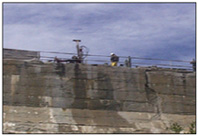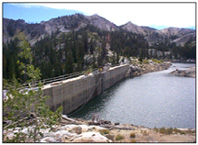Lake Mary - Phoebe Dam Study
Seventy-three year old dam undergoes seismic study
October 2, 1998
|
|
On September 8, 1998 the firm of PC Exploration, Inc. of Woods Cross, Utah was awarded a contract to drill test holes in the structure, and the next day a helicopter flew the drilling equipment to the dam site. Their contract includes coring three test holes through the concrete dam into the supporting bedrock; two vertical and one angle core hole. These holes will be used to measure the water pressure at the base of the dam.
The contractor has collected core samples of the concrete in the dam and the granite bedrock below the dam. These cores will be tested and analyzed. Chuck Call, Chief Engineer for the Department of Public Utilities, in describing the 83-year old structure, said, “We have been very pleased with the quality and condition of the concrete in the dam.”
Water tests were also made in the core holes. “The dam is in surprisingly good condition considering its age,” according to Mr. Call. During these tests, water is forced under pressure into the dam or bedrock to measure how much water the concrete or granite will take. “The dam is so tight that no water could be forced into one of the holes,” Call reported. Piezometers (plastic tubes) were installed in these holes so the water pressures can be measured in the future. This information will help evaluate the stability of the dam and make sure it is always safe.
Mr. Call related that, “We tried to chip off a small piece of concrete used to make this dam with a granite rock and we found that the concrete is stronger than the granite rock.”
|
Questions regarding this article can be directed to: chuck.call@ci.slc.ut.us
Salt Lake City Deparment of Public Utilities (801)483-6785


